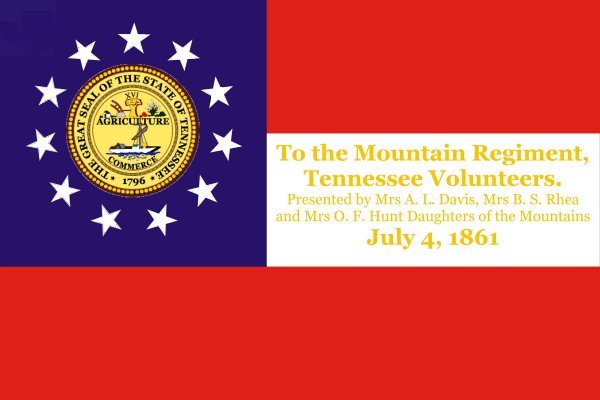
The 'Mountain Flag' (1st National) 1
16th Tennessee Volunteer
Infantry Regiment
Battle Flags
To help those who don't now the Battle Flags listed below by name at some date, hopefully within the next month or two, there will be posted here illustrations of all the Battle Flags mentioned below.
What is a Battle Flag?
They
are the flag that an organized body of men follow into battle. The use of
distinctive Battle Flags was not unique to American Civil War Regiments as for
centuries European Regiments had carried them, other
distinctive insignia had been used from before the Romans. The first
flags carried by Regiments of American citizens was during the War of 1812.
At the start of the Civil War Companies were raised
throughout the South and then formed into Regiments. These Regiments, and
also the Companies, received
Regimental Roster
Company flags
from their local communities, many times these flags were usually presented
with great ceremony.
The only flag that we can be sure
was carried by the 16th Tennessee Volunteer Infantry Regiment was the 'Mountain Flag'.
There is a point of interest is a report by
Colonel John H. Savage, Commanding Officer of the Regiment, written after the
Battle of Perryville (Chaplin Hills), 8 October 1862. After the Regiment
had crossed Chaplains Creek he 'halted
the Regiment, ordered my colour bearers to the front and ordered the Regiment to
dress on them.' As both the words 'bearers' and 'them'
it could be that they were carrying two flags but its probable that
this was the posting of the Regimental
colours, with its colour guard, and the two flank markers.
These flags depicted here have been kindly made by John
Dolan-Heitlinger to what is written here with this in mind any mistakes are
mine. I hope that when John has time he will produce all the others that
this page needs. Any comments please contact me.

The 'Mountain Flag' (1st National) 1
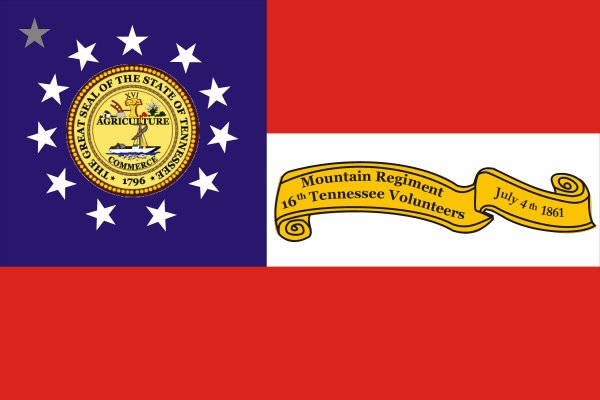
The 'Mountain Flag' (1st National) 2
On 'July 4. Thursday---Clear and hot.
The 16th Tenn. Regt. was presented with a most beautiful flag today by the
ladies of the Mountain district. Capt. A. L. Davis representing them and
addressing the Regt. Col. Savage received it with a few appropriate
remarks.' Another quote 'The
first regimental flag of the 16th Tenn. Inf. was presented 4 July
1861 at Camp Trousdale in a ceremony attended by a part of 18 men, women and
children from the Upper Cumberland.....On
the 6'
x 9'
banner, the state seal was painted on the blue field, encircled by 11 silver
stars, and inscribed on the white bar in gold were the words ‘To the Mountain
Regiment, Tennessee Volunteers.
Presented by Mrs A.
L. Davis, Mrs B.
S. Rhea and Mrs O.
F. Hunt Daughters of the Mountains
July 4, 1861’ (1) A further quote says 'At
three o’clock P.M., Col. Savage.....had his regiment paraded and formed into
line when the flag, six feet by nine, made of the best material to be had, was
duly presented to the regiment. The painting on the blue
field consisted of the shield or
coat of arms of the State of Tennessee, beautifully painted on
both sides, with eleven bright
silver stars in a circle around the shield, with one other dimly
painted representing Missouri' (2)
This flag measured 72 inches by
108 inches and was most likely shot to pieces at
Murfreesboro with the remnants presented to Colonel John Savage. This flag
was made by William J. Fry, Nashville, TN. (Fry advertised his business in the local newspapers saying 'silk and satin flags and banners, gilded and painted to
order').
At least two Tennessee infantry regiments used the First National flag with the Tennessee
State Seal painted in the canton. After the
Battle of Perryville (Chaplin Hills), 8 October 1862, the
Regiments in Benjamin F. Cheatam's Division, of which the Regiment was part,
were allowed to put 'inverted cross cannon' on their Battle Flags,
its unknown whether the Regiment ever did this.
As well as the mentioned eleven stars
there was added a twelve star this twelfth star
being that of Missouri,
which was about to vote on secession.
The two flags are depicted as will be
seen the descriptions are slightly different and as we cannot be sure what the
battle flag looked like these ideas are the best we can do until more
information becomes available.
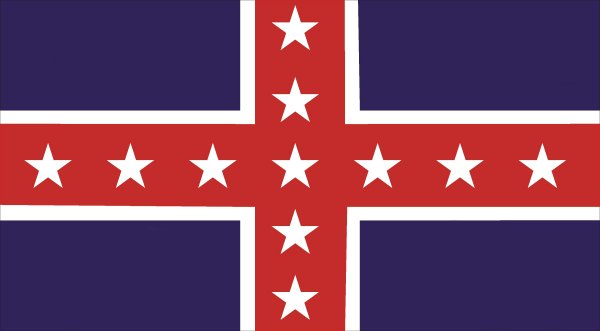
The 'Polk' pattern flag
It will be noticed both the
'Polk' and 'Cassidy' pattern were being issued as Battle Flags at the same time to
Regiments within Polk's Grand Division (Corps), it's quite likely that with the retirement of
the 'Mountain Flag' either of these could have been now issued to
them.
(To help understand the problems with what would be the next Battle Flag for the
Regiment this information covers units that were in
Cheatham’s Division, of which the 16th
Tennessee were members, during the Battles of Perryville and Murfreesboro
(Stones River). This information was kindly produced for me.
The
1st
Tennessee
famously had a 'Polk' Flag.
The 4th
Tennessee
was issued with a 'Cassidy' flag after Shiloh, but before June 1862.
The 8th
Tennessee
was issued a 1st
National Flag in October 1861,
which they carried until it was captured at Murfreesboro.
The 9th
Tennessee
still had there 1st
National after Shiloh, but there is some evidence to suggest that when they were
combined with the 6th
Tennessee,
who were issued with a 'Polk' Flag.
The
19th
and
24th
Tennessee
both had 1st
National Flag, but not sure of the usage.
The 27th
Tennessee
was issued with a 'Cassidy' Flag after Shiloh, but I believe took the 'Polk'
Flag when they combined with the 1st
Tennessee.
At Murfreesboro, some of Vaughn's
Brigades Regiments are reported as having 'Polk' Flags.
Units in Withers Division are also known to have 'Polk' Flags )
Leonidas Polk, the Episcopal Bishop of Louisiana,
had
these flags issued to the cavalry, infantry and artillery of the 1st Grand
Division (later Corps),
the flags had been shipped to Polk on 30 January 1862, and were first carried at the
Battle of Shiloh.
The Regiment joined the Army of
Mississippi (Tennessee) and was assigned to Polk's Corps, Cheatam's Division on
the 23 April 1862. The next order of these flags were made of bunting and cotton, and were smaller than the original issue
and measuring 28 inches by 51 to 52 inches, they were distributed to Benjamin F.
Cheatham's Division on 4 September 1862.
It possible that this flag was
carried by the Regiment as a Corps flag and was lost at Murfreesboro (Stones River), 31 December 1862-3 January
1863, as a
'Polk'
pattern flag claimed to be that of the 16th Tennessee now resides in the Museum of
the Confederacy, Richmond, VA. This measures 29
inches by 52 1/2 inches and has 11 stars. This flag was believed to have been recovered
from the battlefield at Murfreesboro by Daniel W. Adams Brigade. It was rediscovered in Virginia in April 1865
and then transferred to the US war Department in1906. The
flag had been found
lying on the ground over which the Regiment had been fighting, along with three
Companies of the 51st Tennessee. (Two
other Regiments, the 9th
and 44th
Mississippi (Chalmer's Brigade)
had retired in disorder over this ground earlier so its
quite possible that it could be theirs, although the 9th had a 'Cassidy').
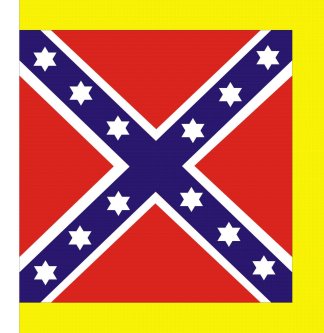
The 'Cassidy' style, 2nd pattern
flag
With the intention of having the Army of Tennessee
adopt a Battle Flag with the style of that of the Army of Northern Virginia Army
Commander Gustave Toutant Beauregard placed the first order with a New Orleans
sail-maker Henry Cassidy, of New Orleans, on the 23 February 1862, these would
become known as the 1st Cassidy.
A second order was placed on the 11 March 1862 for a further 51 flags for
Polk's Corps. They were dispatched on the 29 March but failed to arrive before
the Battle of Shiloh, 6th-7th April. Some time about the end of May they
arrived and were distributed in a haphazard fashion. There were three types
infantry, artillery and cavalry. The infantry flags measured 51 inches high by
45 inches long. Both the 1st and 2nd Cassidy looked the same.
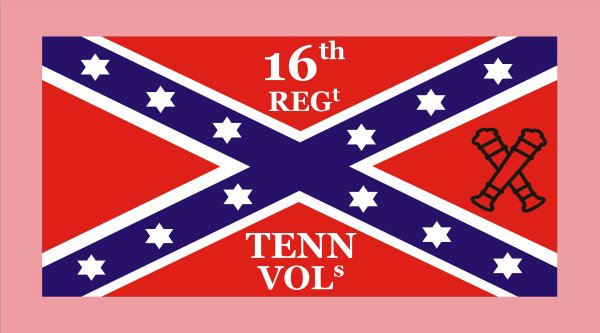
The 'Cassidy' style, 3rd pattern, Army of Northern Virginia
flag
A third order of 31 flags were placed on the 3rd
March 1862 it seems that they were originally for issue to Hardee’s Corps but
they also arrived after the battle of Shiloh and were never issued to this
Corps. They were issued as replacement flags on an 'as needed' basis and
could well have been issued to the Regiment. Only one size was ordered and they
measured 41 inches high by 72 inches long.
(I have been in discussions with Greg Biggs, author of the book
called "Volunteer Banners - Tennessee's Civil War Flags" and contributor
to "Flags of the World", who feels that its more probable that they were
issued with the 2nd pattern Cassidy and not the 3rd.)

1st
National flag
With the retirement of the 'Mountain Flag' after the Battle of Murfreesboro it's replacement could have been the 1st National as a Battle Flag, as many other units carried it as such and this was basically the same as the original flag. The flag measured about 36 inches by 83inches. It was usual to put the regimental name in the white canton in black, although red was also used. This was some times written with the Regimental number on a higher plane. Here are two suggestions.
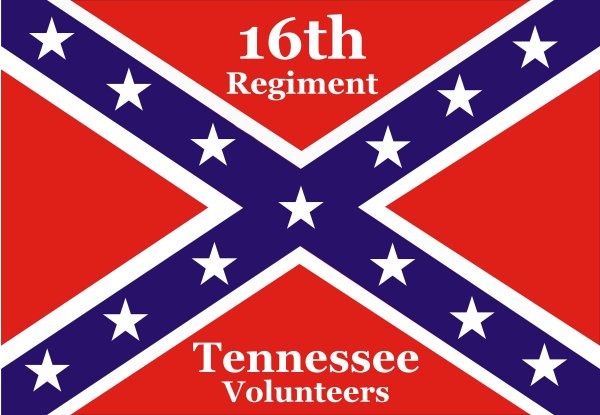
The
'Johnston' style Army of Northern Virginia flag
These flags would most likely have
been carried from early 1864 as when Joe Johnston
again assumed command of the Army of Tennessee, December 1863, he commenced the issuance of a uniform Battle Flag to replace the
half-dozen different designs in service at that time. Early in 1864 probably during March/April the quartermaster
department issued a flag similar to those used by the Army of Northern Virginia,
although rectangular rather than square, it also failed to have the white
border found on the ANV version of that date.
In early 1864, while the Army
was at Dalton, ' orders were received for each Regiment to put their State and
Regimental number on their flags. Thomas Head and Thompson, with the help of a
sign painter, cut letters from fabric, and a young lady sewed them on. When
completed, the flag read: '16th Regiment Tennessee Volunteers.''
The average
dimensions were 36 inches by 52 inches, the Regimental designation were
usually put into the top triangle, with the State in the bottom one, both in white, although there's at least one in existence with a white bar in the top
triangle holding both designations in black. Many of this pattern
flag had Regimental markings on top and bottom also had the same
markings on the left and right on the other side.
Battle honours could be found in the white
border that surrounded the blue cross, written in black. Flags were found with the
unit designation and the State in the top triangular canton and the rest having battle
honours. Crossed cannon are found either in the bottom or the fly triangle
canton, and could be found as the center star in the cross.
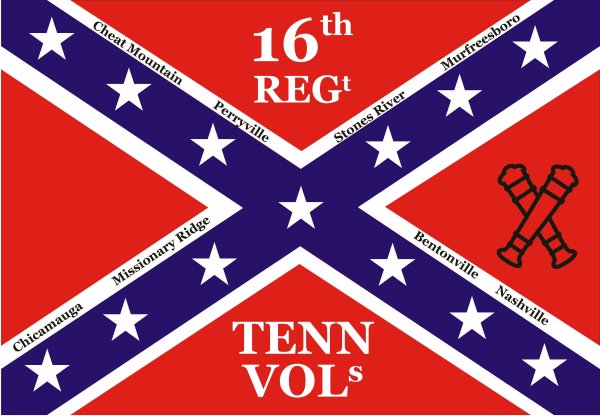
The
'Johnston' style Army of Northern Virginia flag
This is a representation of what the Regiments flag would have looked like if they could have fielded themselves as a separate Regiment.
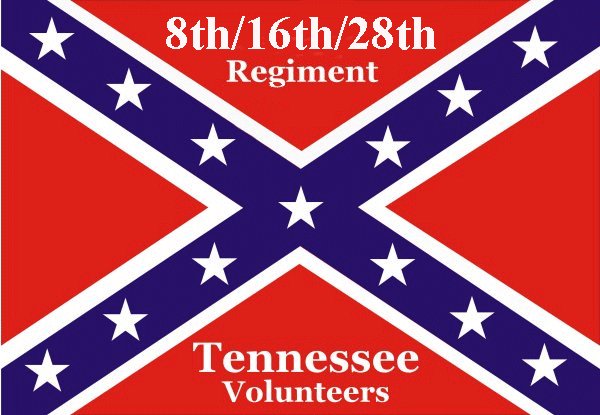
The 'Johnston' style 8/16/28th Tennessee Flag
Due to having suffered large casualties the Army reorganization of 14 September 1864 produced the consolidation together of the 8th, 16th, and 28th Tennessee Regiments into one field unit. This Regiment was Commanded by Colonel John H. Anderson of the 8th Tennessee. With this amalgamation the new Regiment could now have a new Battle Flag due to them although this was not issued. (The Regiments still maintained their individual identities in camp and with roles and documentation so its quite possible that all three still carried their individual colours into battle.)
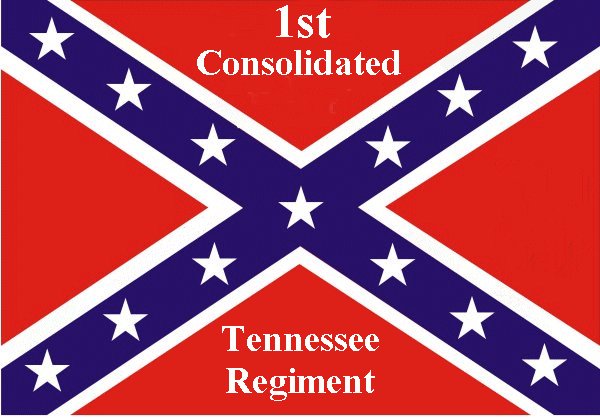
The 'Johnston' style 1st Consolidated Tennessee flag
During the Army reorganization of 9 April 1865 the following units were incorporation into one: 1st (Field's), 6th, 8th, 9th, 16th, 27th, 28th, and 34th Tennessee Infantry Regiments, plus the 24th Tennessee Sharpshooter Battalion. Within this new Regiment what was left of the old 16th formed Companies 'F' and 'K' of the First Consolidated Tennessee Infantry Regiment, Commanded by Colonel Hume R. Field. Once again a new Battle Flag was needed but would never have been ordered let alone carried as the Army was about to surrender.
![]()
![]()